Big Numbers 1-3
Storytellers:Alan Moore and Bill Sienkewicz
Publisher: Mad Love
Year of Publication: 1990
Page Count: 3 issues (120 pages, an unfinished graphic novel)
What I learned about Writing/Storytelling:
1. This is a big book with an ensemble cast. One thing Moore does at the end of issue 1 is give us a sort of montage of all (or many) of the characters: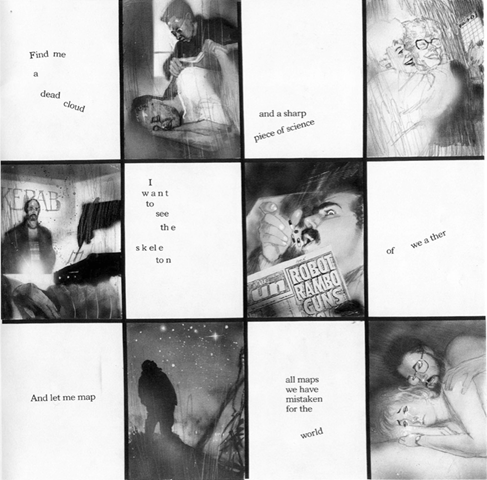
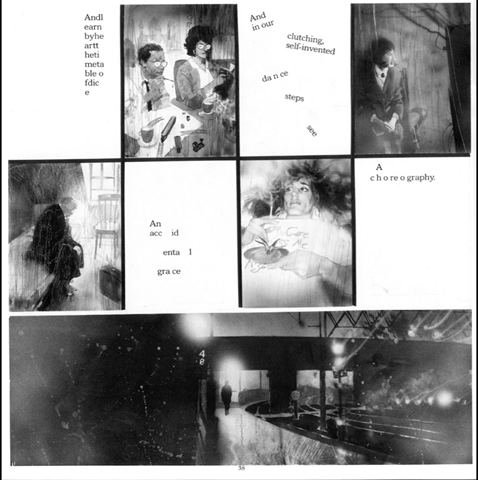
It seems to be saying, in an indirect sort of way, “Here is our cast of characters.”
By playing with the letters in the montage here, Moore slows down the reading order and makes you focus on the letters more, forcing a slow pacing on the reader. And I suppose the bigger panel on the end serves as a sort of punctuation for the poem or a palette refresh going into the next scene.
2. You can control pacing through the grid layout, and, in particular, limiting your grid choices, forcing the creative team to work with a set structure the way a poet needs to work with a set scheme. Watchmen use a formal grid structure to give us a sense of an objective observer. Each panel is the beat of an objective sequence of time, giving us the sense of a harsh, materialistic, mathematically precise universe. It’s hard to judge without reading the entire graphic novel but Big Numbers appears to approach the grid from a more humanistic perspective.
I know there’s been other experiments with set grids. A friend told me that Runaways 1 repeats the same layout when introducing each character (I haven’t gone back and checked) and that the Sandman issue with the African myth uses a specific recurring layout pattern to evoke the rhythm of storytelling in an oral tradition.
3. Moore evokes BIG IDEAS in his story, which addresses the “why should I give care” factor. The story is about the first American style shopping mall opening in the British Town of Hampton. At one point Moore has a history teacher thinking about history, how one group has always come in and replaced the preceding group, starting with tool using humans wiping out other animals, and proceeding through humans invading other human groups: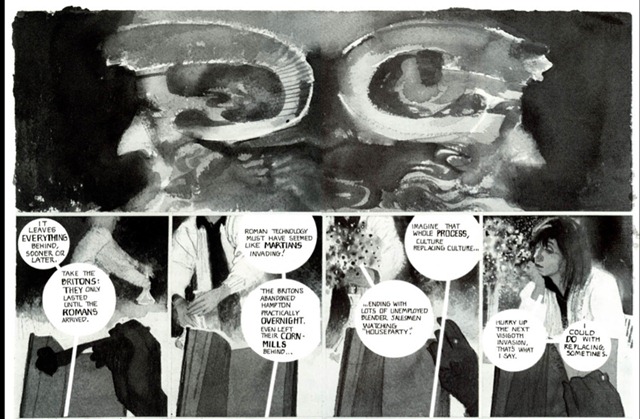
The character in question is not commenting on the American shopping mall, but it’s clear Moore, the author, is making the connection. The Americans are about to wipe out the local British culture, repeating a process in the rise and fall of civilizations.
A newly released mental patient sees the Americans as aliens from outer space. He believes they are from beyond Jupiter, and are his outer space family who has returned: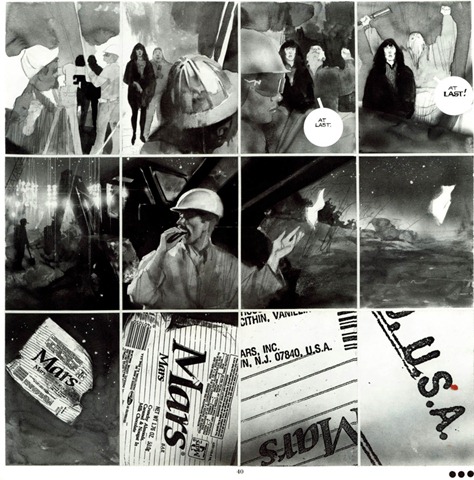
(Incidentally, pacing is tightly controlled through the grid structure here, so that in the second row, we read one big image as if four successive panels.)
The Mars bar of course ironically calls back to the mental patient’s delusions, but also highlights the idea that the Americans are a type of alien. The construction worker isn’t making a statement by throwing a Mars bar into the air, but Moore is, using his characters as akin to notes in a symphony, serving a purpose that is unrelated to the wants and intentions of the individual players.
So.. the answer to why you should care about the mall, Moore seems to be saying, is that events in the microcosm reflect the greater course of human history.
4. Here’s another pacing thing with a big image consisting of little panels: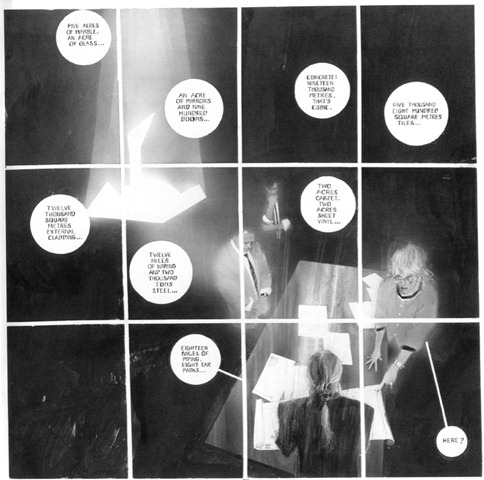
This grid would appear at first blush to not be needed, but it actually guides the panel reading order, without the grid it would be harder to tell which panel to read when.
I don’t know how common this balloon type, is, with the solid lines. It might be a european thing. Among other things, it’s probably meant to evoke the geometries and mathematical principles that form the “Big Numbers” theme of the book.
5. Part of the style of the book comes from the repetitive camera angles, and use of zoomed out shots in general. This is the opposite of the “22 Panels That Always Work” style of art, we’re like a camera, observing the “action” as if a fly on the wall. The action is pretty mundane: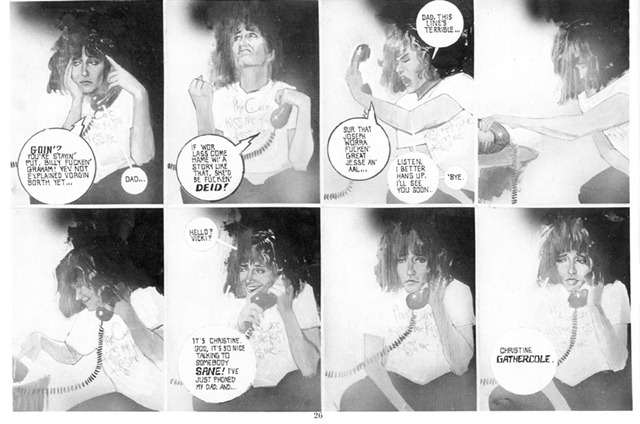
Body language is tremendously important if you are not going to move the camera. Here, the body language indicates the protagonist is bored, upset, agitated, amused, interested, then deflated. I’m not sure how to pull this sort of thing off, but it’s cool if you can do it.
6. The story’s point of view often feels objective, but wanders into the minds of the characters at times. The main character is a writer whose family doesn’t understand her. She left town many years ago after getting an abortion, and has returned for the first time to find a place to relax while working on her novel.Whenever the topic of children comes up, she witnesses a fantasy of what could have been if she kept the child:
That’s my reading of course, Moore doesn’t spell out that she’s imagining the child. We don’t get inside her head. Well, actually, I think we do get inside in her head in a way, but its depicted through this metaphorical flourish. This subjectivity is not limited to one character, there’s a shop owner who will probably be driven out of business by the upcoming American mall. He plays with a model train set and imagines the train set people opening extension stores in America and driving the Americans out of business. (Essentially the plot in reverse)
The art style changes here in a way I initially found startling, as the train set toys seem to talk directly: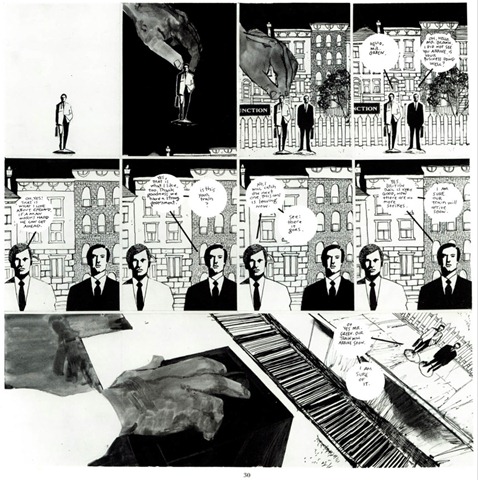
7. Parallelism. For many Moore stories, that’s to be expected. Just as the Black Freighter comic in Watchmen comments or reflects the actions of Ozymandius, the plot threads seem to comment on each other. The mental patient’s delusions about being from space comment on the American characters, while the train set fantasies mirror the lives of the Americans as well. The Americans plan their mall with models, which are not dissimilar to the train set.
A subplot features a board game called “Real Life” that kids are playing, which is another fiction in the fiction, and would presumably comment on the various elements of the modern adult world depicted in the rest of the story if the comic had continued.
The main character is attempting to write a book (she tries to begin in issue 3 three but tosses out her first pages) As the book progresses, presumably the novel would somehow interconnect as well.
8. I guess another take away would be attention to detail, the little things people do to fill up the days of their life. Quoting this blog post:
Quote
The third installment remains guided by the view of human interaction that informed the scenes in the first two chapters. Every person is regarded as an idiosyncratic entity, with those idiosyncrasies finding expression in routines and behavioral patterns. Alienation, which defines virtually every relationship Moore depicts to some degree, results from those patterns meeting, coming into conflict with each other, and creating tension. People then either retreat from one another, or they fall back on routines intended to bring the tension level down, such as making jokes or following through on courtesies. Moore apparently sees behavioral constants as the means through which people impose order on the uncertainty of their lives.
http://polculture.bl…moore-bill.html
Of course the book, train set, games and the like are part of these “behavioral constants”.
9. Issues 3 uses a unifying structural device in the form of a marketing survey being given door to door to various characters. We cut from scenes, sometimes not survey related, always comfortably back to something survey related. This gives a sense of structure to the chapter.
Recommendation: A
Notes/Reviews/Synopsis:
This is an unfinished graphic novel, intended to last for 12 issues. As such it not a complete story, just a fragment of one, and is really just for Alan Moore completests. Nevertheless, due to the complexity and ambition on display, I give it an A.
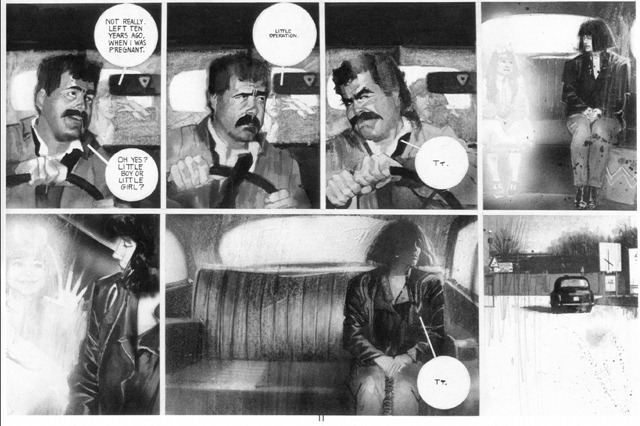
Nice post. I’d mention how the table is framed in point four against the family breakfast table shown elsewhere. I don’t have Big Numbers handy but I recall a resonance of some kind.